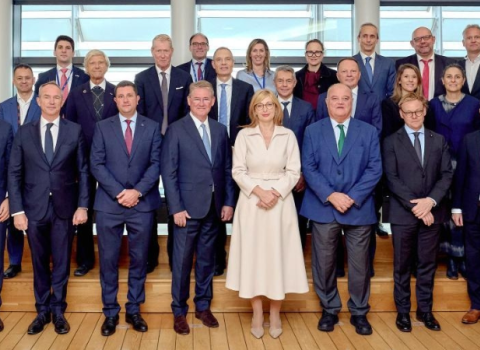On May 24 the European Commission made a commitment to create a single market for intellectual property rights. In a series of articles we will be looking into the details of this latest initiative, reporting on progress, and assessing outcomes
IP|Business is supported by Foley & Lardner LLP
On May 24, 2011 the European Commission announced a 2011 priority initiative to create a single market for intellectual property rights1. The Commission has a strategic vision for a single IP market, which is currently fragmented among the EU member states. According to the Commission, creation of a single market for intellectual property rights (IPR) would act as a catalyst to boost creativity, innovation, and economic growth.
Over the course of the coming months through the Science|Business portal, Foley & Lardner LLP will be analyzing this initiative, reporting on its progress and providing an assessment on likely outcomes. This first in this series article describes the current legal context and the Commission’s key proposals to deal with what it sees as serious roadblocks to innovation.
Since the earliest efforts in post-World War II Europe to create a single common market, the free movement of people, goods, capital and services has been one of the most important fundamental building blocks to the achievement of that goal. However, the several treaties that have been negotiated among the member states, have always reserved to the member states the jurisdiction to control the creation and enforcement of IPR, particularly patents.
Complex, fragmented, costly
For several decades at least there have been numerous efforts to change that allocation of power and develop a unified and harmonized system of IPR. The current system is complex, fragmented and costly2. However, these efforts have ebbed and flowed and have encountered significant opposition from EU member states which sought to protect their ability to control IPR in their respective jurisdictions, as well as serious “constitutional” hurdles in the way of simplifying and harmonizing the system. Indeed, as recently as three months ago, the EU Court of Justice rejected an agreement to create a unified patent litigation system3.
Despite these setbacks, the European Commission seeks through this Communication to rekindle the hopes and political momentum for the achievement of a single IPR market. The Communication and the initiatives it contemplates cover all IP rights, such as patents, trademarks, copyright and trade secrets, as well as initiatives in the area of IPR enforcement.
In the area of patents, the Commission has already presented the proposals for implementing measures to create a unitary patent in the framework of enhanced cooperation. These proposals are currently being discussed in the Council and Parliament and a common political approach may already be reached by the Member States’ representatives, at the next Competitiveness Council. At the same time, the Commission is working on the proposal for the jurisdictional arrangements, taking into account the Court's Opinion on the proposed unified patent litigation system 4.
As regards trademarks, contrary to the current very decentralized patent system, national trademark registration has been unified for nearly 20 years and a EU trademark has existed for almost 15 years. However, the Communication notes that a review is currently under way. Issues being assessed include (1) simplifying and expediting the registration process; (2) increasing the legal certainty of Community trademarks; (3) clarifying the scope of EC trademarks; and (4) identifying additional steps toward harmonization and cooperation. On the basis of this review, the Commission will present proposals by the end of 2011. However, no major overhaul of the system is foreseen.
Parasitic copies
As concerns copyright, the Commission intends to present several proposals to address the issues of collective rights management, orphan works and private copying levies. For trade secrets and parasitic copies, the Commission does not yet have specific proposals, but it is studying the current situation and the ways in which the issues can be addressed.
The Communication notes the Commission’s continuing efforts to improve the fight against counterfeiting and piracy and it plans to review the 2004 IPR enforcement Directive in early 2012, building on the report on the application of the Directive that was published in December 20105.
The Commission premises its proposed unified IPR system on important economic goals. This initiative is linked by the European Commission with other important priority goals seeking to stimulate job creation and economic growth (6). According to the Commission, innovation is essential not only for the European economy to grow but also to help address critical challenges for the 21st century, including ensuring food security, dealing with climate change, confronting increasing demographic challenges and fostering cultural diversity7.
The Commission views the rationale for its call to reform as self-evident given the importance of IPR to the everyday life of EU citizens and to the competitive challenges faced by EU industries, whether SMEs or multi-national enterprises.
Again, Foley & Lardner LLP plans a series of follow-on articles to explore in greater depth the details of this important initiative. Please contact Foley & Lardner LLP IPR experts, particularly Drs. Richard Peet and Rouget Henschel, whose practices focus on cutting edge EU IPR issues.
References
1 Communication from the Commission to the European Parliament, the Council, the European Economic and Social Committee and the Committee on the Regions, Com (2011) 287 final (24 May 2011).
2 Ibid at 7. According to the European Commission, the cost to obtain a European patent in but 13 of the 27 member states costs 10 times as much as a comparable U.S. patent.
3 Opinion 1/09: TFEU – Draft agreement – Creation of a unified patent litigation system – European and Community Patents Court – Compatibility of the draft agreement with the Treaties. (EU Court of Justice, March 8, 2011)
4 Ibidem.
5 In general terms, a "Directive" is a legislative act of the European Union mandating all member states adopt national laws aimed to achieve a stated European Union policy objective. A directive is an order from the EU to its member states. Failure to comply can result in litigation commenced by the European Commission to compel action. However, each individual countries has some limited discretion to decide how to achieve the goals when transposing the Directive into their national legislation. A Directive is thus distinguished from a "Regulation", another type of EU legislative act which is immediately enforceable in all member states and does not need to be transposed. The IPR Enforcement directive 2004/48/EC OJ L95/16 (June 2, 2004) sets forth a number of specific legislative actions EU member states must adopt to facilitate the enforcement of IPR including, among other things, permitting actions for damages and the seizure of infringing goods. Such remedies are, of course, subject to corresponding rights of defense. For an overview of the Commission’s proposed review, see the recently published report on the IPR Enforcement Directive, http://ec.europa.eu/internal_market/iprenforcementdirective_en.
6 See, e.g., Communication on Europe 2020 Strategy (Com (2010) 2020).
7 Supra n. 1 at 3.





 A unique international forum for public research organisations and companies to connect their external engagement with strategic interests around their R&D system.
A unique international forum for public research organisations and companies to connect their external engagement with strategic interests around their R&D system.